#the presentation style. the dedication. the analysis.
Explore tagged Tumblr posts
Text
youtube
i'm ngl this is probably one of the best youtube videos i've ever seen. highly recommend taking an hour to check it out. you will be amused and amazed. top-tier gaming content right here
#i can't explain it it's just so good#the presentation style. the dedication. the analysis.#my friends can't stop talking about it too#youtube#heavy rain#video games#video#my post#Youtube
3 notes
·
View notes
Photo

From Cyrus to Alexander: A History of the Persian Empire
"From Cyrus to Alexander" by Pierre Briant offers a detailed history of the Persian Empire, focusing on its administration, culture, and military. Briant highlights Persia’s innovations in governance and its tolerant, multicultural approach. The book challenges traditional Greek-centric views, presenting Persia as a complex and influential empire with a lasting historical legacy.
Pierre Briant’s From Cyrus to Alexander: A History of the Persian Empire is widely considered the definitive modern history of the Persian Empire. The book covers its origins under Cyrus the Great through its conquest by Alexander the Great. Originally published in French as Histoire de l’Empire Perse in 1996, the English translation made this monumental work accessible to a wider audience, expanding its influence in Near Eastern studies, ancient history, and comparative empires.
Briant’s book stands out for its focus on presenting the Persian Empire as an autonomous civilization rather than through the perspective of its Greek rivals. Historically, much of what Western scholars knew about the Persian Empire came from Greek sources like Herodotus, who often cast Persia as a monolithic enemy. By situating Persia at the center of its own narrative and making extensive use of archaeological findings, inscriptions, and administrative records, Briant counters this Eurocentric bias and offers a view of Persia as a sophisticated, multiethnic empire that left a significant legacy of governance, culture, and trade.
Briant structures the book in a way that mirrors the breadth of the Persian Empire, dedicating each section to a different aspect of the empire’s history, politics, economy, society, and culture. The organisation of the book reflects his emphasis on a systemic, comprehensive examination of the empire.
The early chapters detail Cyrus the Great’s conquests and policies of tolerance, which established a stable, expansive empire. Briant also examines governance, highlighting the balance between central control and local autonomy, the role of satraps, and the unifying use of Aramaic as an administrative lingua franca. Moreover, he analyses the Persian military apparatus, from its elite units like the Immortals to the logistical organisation enabling vast mobilizations by the Persians. He contextualises major conflicts, including the Persian Wars as part of a strategy to stabilize borders and secure valuable territories, rather than dominate all of Greece.
The book also dedicates significant attention to the Persian economy, exploring the empire’s agrarian base, trade networks, and taxation system. He shows how Persia’s economic policies were designed to support both the imperial treasury and local economies, creating a sustainable model that contributed to the empire’s longevity. The culture and religion section highlights Persia’s promotion of cultural integration and religious diversity. Briant shows how Persian art blended regional styles to symbolize royal authority and examines how Zoroastrian traditions coexisted with support for local religions, fostering loyalty among subjects.
One of Briant’s central arguments is that the Persian Empire’s strength lay in its policy of tolerance and inclusion. By allowing conquered peoples to retain their religious practices, local laws, and leaders, the Persians created a sense of allegiance that went beyond military domination. He also highlights the Persian administrative system as a model for later empires, like the Roman and Islamic. Innovations such as standardized taxation, the Royal Road, and an organised postal system enabled centralised yet flexible governance. His analysis of satrapies shows how Persia balanced regional autonomy with loyalty to central authority.
The book repositions the Persian Empire within a global context, highlighting its role in economic and cultural exchange across Asia and the Mediterranean. Through trade and diplomacy with regions like Egypt and Greece, Persia facilitated the flow of ideas and technologies, serving as a prototype for managing diverse populations and complex trade networks.
From Cyrus to Alexander is widely praised for its depth but critiqued for its daunting length and scholarly density. While excelling in its analysis of Persian administration and politics, it offers limited insight into the daily lives of ordinary Persians, focusing more on imperial strategies than social and cultural history.
This monumental work offers a detailed and balanced account of the Persian Empire, redefining its role in world history. Briant’s focus on understanding Persia on its own terms provides valuable insights into its governance, economy, and cultural integration, making it an essential resource for ancient Near Eastern studies.
Continue reading...
81 notes
·
View notes
Text

@heartdeceives
Spencer was excited to attend the lecture at NYU, especially with Professor Bloom as the guest speaker. Having read Bloom's work, Spencer was intrigued by his unique writing style and was eager to hear his insights in person. The opportunity to engage with Bloom's ideas firsthand was one he couldn't pass up. Spencer had taken time off from the BAU to attend this lecture, knowing that such opportunities were rare. He was confident that the insights gained from Bloom's lecture would contribute to his professional growth. This decision to step away from his usual duties was driven by his passion for continuous learning and intellectual exploration. Spencer arrived at the NYU campus with a sense of anticipation, quickly making his way to the lecture hall. He took a seat in the front row, eager to absorb every word of Professor Bloom's presentation. As the room filled with fellow attendees, Spencer felt a surge of excitement, knowing he was about to witness a memorable intellectual experience. Spencer knew the real reason behind Professor Bloom's sudden hiatus from lecturing years ago, but he respected the professor's privacy and had no intention of bringing it up. He understood that sometimes personal matters were best left unspoken, and he was more interested in the knowledge Bloom had to share. As the lecture began, Spencer focused intently on the professor's words, eager to gain new insights and expand his understanding.
Spencer listened to Professor Bloom began his lecture by discussing the evolution of writing styles throughout history, highlighting the impact of cultural and societal changes on literary techniques. He delved into the works of several renowned authors, including Stephen King. He noted how King's ability to blend suspense with vivid character development set him apart in the horror genre. Spencer listened intently, fascinated by Bloom's analysis of King's pacing and tension. He realized it could be applied to his own work in understanding criminal narratives. Bloom quoted one of Stephen King's famous lines about writing: "Amateurs sit and wait for inspiration, the rest of us just get up and go to work." Spencer chuckled softly, amused by the simplicity and truth of the statement. It reminded him that dedication and perseverance were key elements in any field, whether writing or criminal analysis. As Spencer absorbed Bloom's insights, he marveled at how seamlessly the professor applied King's techniques to his own lecture style. Bloom's ability to weave suspense and engagement into his academic discourse was a testament to his mastery of the art of communication. Spencer felt inspired to adopt a similar approach in his work, recognizing the power of captivating storytelling in conveying complex ideas.
Spencer was so engrossed in the lecture that he eagerly participated in the discussion. Each time Professor Bloom posed a question, Spencer raised his hand, confidently providing the correct answer. His deep understanding of the material and enthusiasm for the subject made him stand out among the audience. Some of the other students exchanged glances, clearly annoyed by Spencer's eagerness to answer every question. They felt overshadowed by his constant participation and wished for a chance to share their own thoughts. Despite this, Spencer remained oblivious, fully immersed in the exchange of ideas and the thrill of intellectual exploration. When the lecture ended, Spencer waited patiently as the other students filed out of the room. He approached Professor Bloom with a keen sense of admiration and gratitude, eager to express his appreciation for the insightful session. Professor Bloom, you analyzed King's work incredibly. Your ability to relate his themes to writing styles was phenomenal." "I've never thought about writing that way before," he exclaimed, his eyes alight with enthusiasm. "Your lecture opened up a whole new perspective for me, and I can't wait to apply these techniques to my own work." Spencer's excitement was palpable. "Forgive me for not introducing myself," he continued, a slight flush of embarrassment coloring his cheeks. "Where are my manners? I'm Dr. Spencer Reid."
43 notes
·
View notes
Text
Merlin Starhawk's character design (an analysis)
Back when I started playing AFKJ some three months ago, my Merlin looked very different. Some things have stayed consistent with him; his pointy but short ears, black lipstick, glasses, his bitchface, his transgender identity, and his fashion sense being on the sophisticated side.

His initial design is rather different (no horns, no hat, shorter hair), the art style skews more realistic and less anime.

The second version is where you can see the recognizable aspects of his design take shape. The style is also more anime now. His hat is present, although it's missing a tassel, and his hat is far smaller. He used to have a cape and dressed in a more boring way. His glasses are also missing in these sketches, but I just forgot them lol. Another sketch has him with horns and a tail- I did keep the horns.

And finally, the third and last version of Merlin. His design and theme have solidified. Stars, a motif of lightbearer designs as well as a nod to the pentacle, and plants, a motif of wilders and his connection to the earth. (Fun fact- his horns are muntjac antler-inspired.)
My main inspirations for his design were classic depictions of the Merlin from from various legends ( and Starhawk's story also parallels Merlin; being half-demon/non-human, prophecies, shapeshifting) and stereotypical depictions of wizards in the modern day.
What comes to my mind when I hear "wizard" is an old man with a long grey beard and hair wearing a hat and cloak covered in stars. (Also, to let you in on a secret, one piece of inspo were wizards from Adventure Time from that season 1 episode. The tassels are probably subliminal influence from Orville Peck. The coins are based on Ukrainian jewelry from hundreds of years ago, replaced with Esperian coins. And the bell? My cats wear bells. I think it's cute.)
I took that in a different direction to subvert expectations you'd have of a great wizard- the great Merlin isn't some old human, he's a 20-30 year old stuck in time, bumbling his way through life, queer and plagued with joint pain and fainting episodes. He is wise but never takes his own advice. He is dedicated, kind, and all too forgiving, but is often lazy and petulant. He's antisocial and blunt but dresses finer than people do in the royal capital.
Besides inspo from some elves and small bits of inspo I took from all over the place, I also used Mirael and Celestials as reference, to draw a connection between them. I kept his colors bright and cool to make him stand out from all designs in game, which are muted, to show that he's built different.
He's a creep, he's a weirdo, and that's about it.
#i could go on#i would love to actually#afk journey#magister merlin#merlinverse#magister merlin starhawk
19 notes
·
View notes
Text
You Say Potato, I Say Excellent! Or blocking, dialogue and legacy of morality tales in ‘The Resurrectionists’ minisode PART I
Alternate title: how Aziraphale’s naivety in this episode was supposed to make you a bit outraged
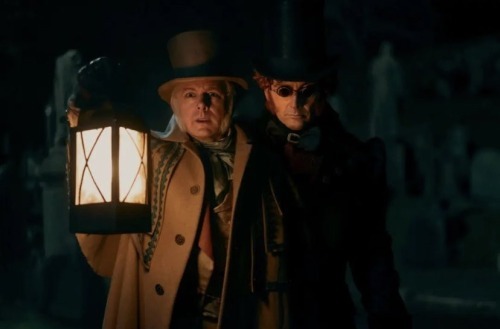
I have to shout out to @bowtiepastabitch for their AMAZING historical analysis of this minisode - it prompted me to finish this long ramble that has been drifting in my notes. Anyway, I have a major obsession with the ways blocking and dialogue interplay in Good Omens - you can check out my analysis of the blocking in the flashbacks in S1. But The Resurrectionists is really something special. This got so long I am splitting it into two parts. See Part II here!
I should start with three important caveats that brought me to this analysis -
If we accept that S1 is narrated by God, then I propose that S2 is being told from the viewpoint of our Ineffable Man Shaped Beings - and they are NOT reliable narrators.
All three minisodes share a feeling of being… stories. They feel like a slightly exaggerated version they might be told between two old friends sitting in the back room of a bookshop, soused off wine and whisky. Like a journal entry that you don’t actually expect outsiders to see.
All three minisodes have some relation, in style and structure, to film and literature. I'm focusing on the lit aspect here. A Companion to Owls is very illustrated bible. Nazi Zombies from Hell is a pulp fiction master class. So what is The Resurrectionists? A morality tale.
My first thought when we opened on the romantic graveyard date in Edinburgh was “OH it’s like a penny dreadful!” but it didn’t take me long to reassess. Morality tales are a genre of children’s literature that was extremely popular in the early 1800s where the minisode is taking place. But THIS morality tale itself is a more nuanced version of these stories, more along the lines of what an author important in the Good Omens universe would pen. So, first, a little bit of history behind morality tales and a very important author to know, then we get to the blocking and dialogue!
Morality Tales for Children
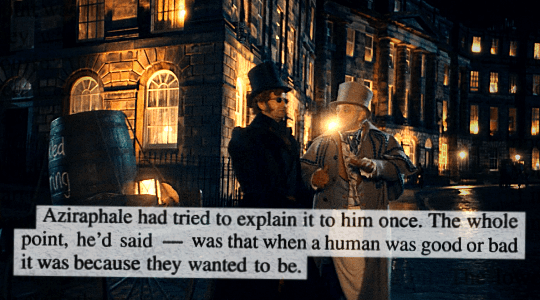
There had long been differing views in European circles of thought about the nature of children - were they born innately tainted by Original Sin, or were they born as blank slates? In the late 1700s to early 1800s, the view of the blank slate was winning with the help of highly influential educators like Friedrich Froebel (who coined the term kindergarten and emphasized the importance of play in learning.)
At this same time, there was a rise in literature produced specifically for children. One of the most popular children’s genres? The morality tale. These stories showed Good triumphing over Evil and the importance of leading a respectable, Christian life. The stories were extremely binary, black and white in their presentation of morality, something which deeply influenced many authors who were raised reading them. Authors like G.K. Chesterton.
G.K. Chesterton
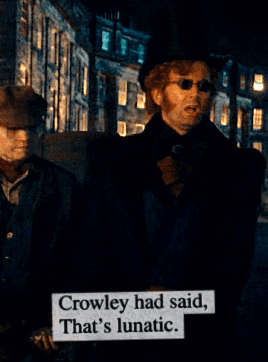
Over his career, Chesterton wrote several plays, 80 books, 200 short stories, 4,000 essays, and several hundred poems. He’s an interesting guy, but suffice to say for our purposes - he was deeply Christian, and his work contains a lot of religious themes and symbolism which he used to write serious commentary on politics, economics and philosophy. If you haven’t read the book, you should know that it the dedication reads thus:
The authors would like to join the demon Crowley in dedicating this book to the memory of G.K. Chesterton.
In fact, Crowley says in the book that Chesterton was “The only poet in the twentieth century to even come close to the Truth." So it is probably relevant that Chesterton had opinions about children’s morality tales. He once wrote -
Many people have wondered why it is that children's stories are so full of moralizing. The reason is perfectly simple: it is that children like moralizing more than anything else, and eat it up as if it were so much jam. The reason why we, who are grown up, dislike moralizing is equally clear: it is that we have discovered how much perversion and hypocrisy can be mixed with it; we have grown to dislike morality not because morality is moral, but because morality is so often immoral. But the child has never seen the virtues twisted into vices; the child does not know that men are not only bad from good motives, but also often good from bad motives. The child does not know that whereas the Jesuit may do evil that good may come, the man of the world often does good that evil may come.
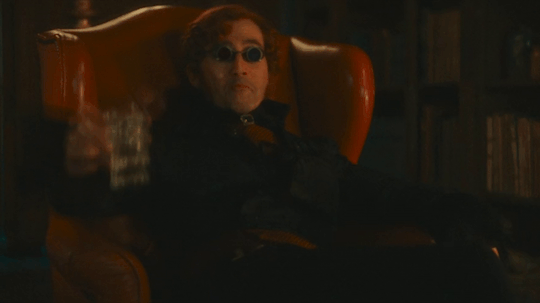
In summary, we know that children’s morality tales were supposed to teach important lessons about Good and Evil. We also know that later authors like G.K. Chesterton were aware of this genre and it influenced their writing (which in turn informs the Good Omens universe). So why pick this framework for this minisode? Because it is FRUSTRATING to watch, on purpose. We are meant to be annoyed with how Good has so little relation to right, to see how complicated doing real good can be, and it lays out a strong case for the complete inadequacy of black and white world views - and not just religious ones.
So (grabs gloves and a knife) let’s dissect the blocking and dialogue, shall we?
Part II: Blocking and Dialogue
#good omens#good omens meta#the resurrectionists#just theatre kid things#history is my jam#look the blocking has me feeling things#shades of gray
57 notes
·
View notes
Text
What is Fantasy? - Poll Analysis
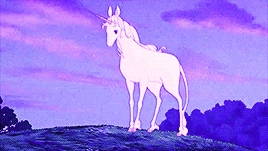
(The Last Unicorn was not one of the polls lol)
A while back, I posted a series of polls titled "What is Fantasy?" that each presented a work of fiction for Tumblr to judge. This activity is one that I used to do with my Fantasy literature class when I was a high school teacher. Unfortunately, I lost the results of the Google Form I used to poll students, so Tumblr has become my new source of data for examining the mainstream perspective of the Fantasy genre. Overall, based on conversations my former students had and responses from these Tumblr polls, we can see a few patterns in the approach people seem to take when identifying a work of fiction as a Fantasy text.
I'll be doing a two-part series about this topic on my Substack (jerseka.substack.com) when I get it up and running (there's nothing there yet). This post is going to be an informal thinking space/rough draft, and I welcome any commentary, criticisms, or additions!
Poll results and analysis below the cut:
For these Tumblr polls, I used fifteen works that can all be labelled as speculative fiction. Speculative fiction as a category is inconveniently broad, especially for more precise discussions about genre conventions, quality, impact, etc. Fantasy, for instance, is distinct from sci-fi, horror, and dystopian literature, although to what extent is up for debate--which is what we're doing, essentially. At the heart of it, most people know--or think they know--which works would be housed in the fantasy section versus the horror or sci-fi sections of a library, streaming service, etc., but they don't always know why, and they don't always agree, and they often don't agree with what scholars have to say on the matter. We can, however, identify some common patterns of thinking. After taking polls and hearing thoughts, here are the most common factors that I've noticed for determining whether a work is fantasy:
The presence of anything unreal
Structure
Setting
Common stereotypes/characters/features
Style/mood
Not surprisingly, the work with the highest number of "Yes: Quintessential Fantasy" votes was The Lord of the Rings. Surprisingly, some people did not vote it as quintessentially fantasy.
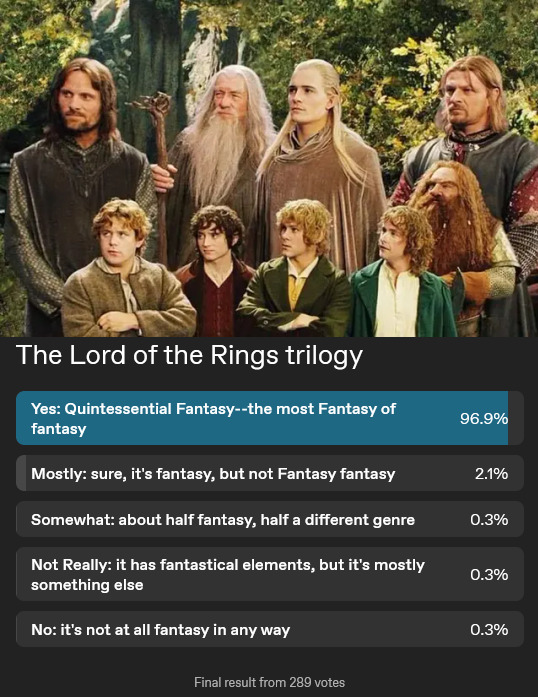
The Lord of the Rings tends to represent what most people expect from a fantasy story based on all the criteria above: there is magic, the structure can be said to follow the hero's journey, the setting is a fictional world with ample dedicated worldbuilding, the tone is epic with a uplifting core, and it has all the fantasy elements that people expect--elves, wizards, rustic inns, castles, and whatnot.


Following LotR, Avatar: The Last Airbender and Harry Potter were also generally categorized as "Quintessentially fantasy." Both of these works have fantastical elements, hero journey style structures (or at least quest structures), the epic and comic (happy ending, not funny) style of fantasy, and some things we commonly expect in fantasy, such as strange creatures and magical places. Interestingly, my former students had multiple heated discussions about Harry Potter. For some of the high school students, it represents their generation's most visible fantasy work, and they would rank it as the top tier fantasy above LotR. For others, the setting made it less fantasy, even to the extent that some of them argued it wasn't fantasy at all. Since Harry Potter takes place in modern Britain--not a fictional world, not the far-off past--it is less fantasy than other fantasy in some people's eyes. Tumblr seems to have a similar thought process; the worldbuilding and setting do not qualify Harry Potter as being "pure fantasy," it seems:

Likewise, A:tLA does not fit many fantasy stereotypes--its setting may be considered fantastic, but many of my former students argued that it lacked the medieval-style feeling they expect with fantasy. The magic elements are also generally not called "magic"; bending is fantastic, but some people seem to consider it as distinct from the kind of magic found in LotR and HP.
The setting and stereotypes argument also came up heavily when debating Star Wars. My students tended to fall either into the "sci-fi" or "fantasy" camp and usually passionately so, with little desire for compromise. The results from the Tumblr poll showed that many people consider it 50/50, which suggests a little more openness to seeing the ways it blends genres. The votes are spread across the options, with the fewest at "No," but it seems Tumblr leans towards fantasy for Star Wars--an interesting development.
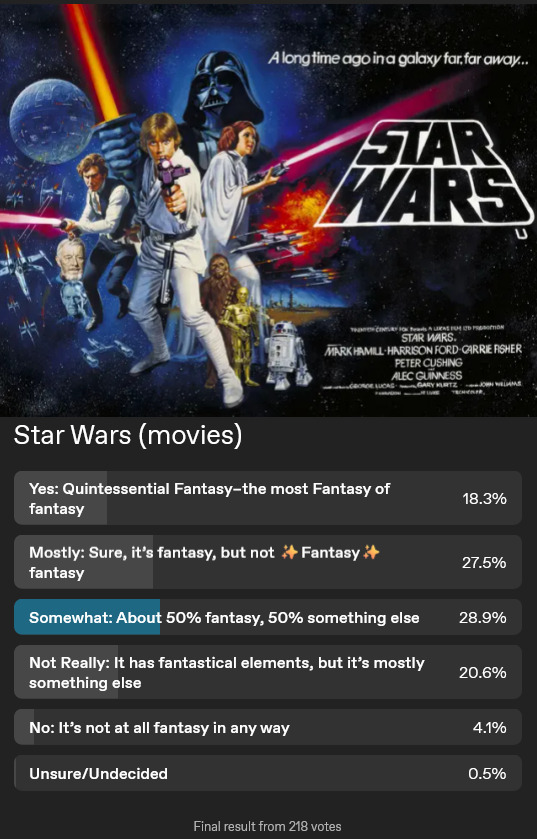
It's easy to see why the debate exists. On one hand, Star Wars was actively constructed to follow the hero's journey, which is a structure commonly associated with fantasy, and the presence of Jedi and the force puts it squarely into the "magic" category in the eyes of many. Some students even called it "Harry Potter in space" and pointed out how similar "Long ago in a galaxy far, far away" sounds to "Once upon a time." On the other hand, space as a setting is not commonly associated with fantasy works, and many material elements of the story are often associated with sci-fi, like laser guns and spaceships.

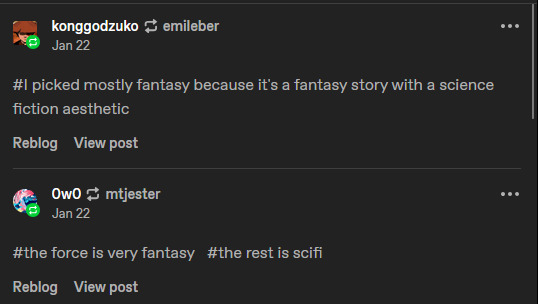
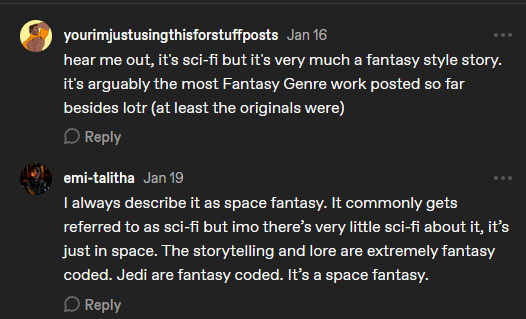

So which element should we focus on when deciding whether Star Wars is a fantasy or a sci-fi work? What should we prioritize? The question many not matter on its own, but it we were asked to shelf the DVDs in a library (lol), label them for a streaming service, or sell the movies to an audience, the question becomes a little more substantial. If we were advertising the movies, would we call them a fantasy? Space fantasy, perhaps. Science-fantasy, maybe. At least streaming services may allow us to label them "sci-fi/fantasy," whereas physical spaces like libraries may force us to pick between a "fantasy" and "sci-fi" shelf (this example is obviously more applicable to books).
The other side of the coin, at least in my opinion, is the MCU. I'll admit that I muddied this choice by choosing to represent the entire MCU as a whole rather than a single movie. My students were angry with me about this. "Iron Man is sci-fi and Doctor Strange is fantasy," they'd say (paraphrased). I did do this on purpose, and not just because I found it funny (but not not because I found it funny).

The MCU as a whole pushed my students (and Tumblr) to consider the line between fantasy and sci-fi. Unlike with Star Wars, despite the clearly fantastical elements of MCU such as the Infinity Stones and the presence of literal gods (who are aliens actually?), most people leaned towards sci-fi with the MCU. Not as many people commented on this post as Star Wars, suggesting less passion for their stance, but here's some rationales:


I like the comment, "Magic alone does not equal fantasy" (thank you @yourimjustusingthisforstuffposts). Let's return to the list we started with:
The presence of anything unreal
Structure
Setting
Common stereotypes/characters/features
Style/mood
Unlike Star Wars, there's less of a fantasy mood to the MCU, one could argue. Perhaps one of the most convincing reasons for this, I'd say, is that the MCU itself seems to distance itself from fantasy--it often tries to explain away the fantastic with science-y type explanations, even if they are often pretty bullshit. It leans more heavily into the sci-fi elements it has. I would argue that American-originated mainstream media targeting adults tends to try to explain away magic, and Ursula Le Guin also argues something similar in "Why Are Americans Afraid of Dragons?" But that's for a different post.
Also of interest in terms of the sci-fi/fantasy debate, here are the results for Homestuck and Gundam:


These works follow the same pattern as Star Wars and the MCU in many regards. Gundam has few of the elements most people would consider fantasy, and Homestuck has many fantasy elements but presents them in a "the is a video game" sort of sci-fi shell.
A number of the other works I included in the polls were meant to be distractors; the Matrix and Ready Player One have fantasy elements, but those elements are largely a result of technologies that are supposedly (or presented as) plausible. Richard Mathews in the book Fantasy: The Liberation of Imagination cites author of fantasy and sci-fi Orson Scott Card to define the difference between sci-fi and fantasy: "If the story is set in a universe that follows the same rules as ours, it's science fiction. If it's set in a universe that doesn't follow our rules, it's fantasy" (4). By that definition, neither of these works are strongly fantasy, and generally, most people agreed as much (72.9% of Tumblr said RP1 is not really or not at all fantasy, and 76.7% said the same for The Matrix). It was also a distractor, as it fits squarely in the horror genre, and 72.2% of Tumblr users agreed. My students did have a small debate about It and Stranger Things (more fantasy than It but arguably still horror-adjacent), which brings us to the most liberal stance on fantasy: anything fake is fantasy.
The stance that anything remotely unreal belongs in the fantasy genre is not common and doesn't represent the majority, but the faction is large enough to deserve notice. I had several students who argued this point. Looking through the polls, every single work had somebody who voted "Yes: Quintessential Fantasy," with the lowest percentage belonging to Ready Player One at .8% of 118 votes. Some of these votes may come from trolls, but discussions I've heard make me believe that there are people who voted honestly this way. Yes, on Cars, Stephen King's It, Pokemon--my students had Spongebob as a choice in their polls, and for some, it was quintessentially fantasy. To be clear, I'm not stating that this position is factually incorrect, as there is distinct subjectivity to this debate. It's just somewhat impractical as a categorization criteria. For that reason, I find it pretty funny.
Cars, Pokemon, and Looney Tunes (and Spongebob) were chosen for these polls precisely because they are unlike stereotypical fantasy but do include decidedly fantastical elements. For instance, cars cannot actually talk. The line between "is it fantasy because it's not real" and "is it fantasy because it follows fantasy conventions" comes out clearly with these works.
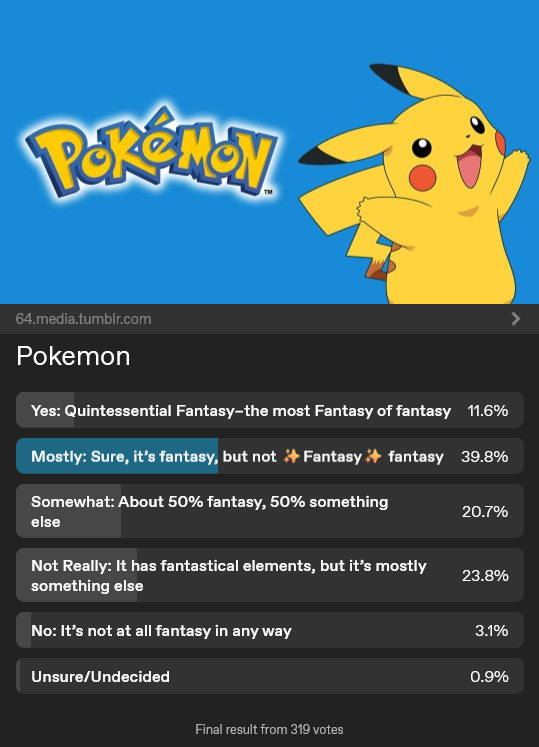
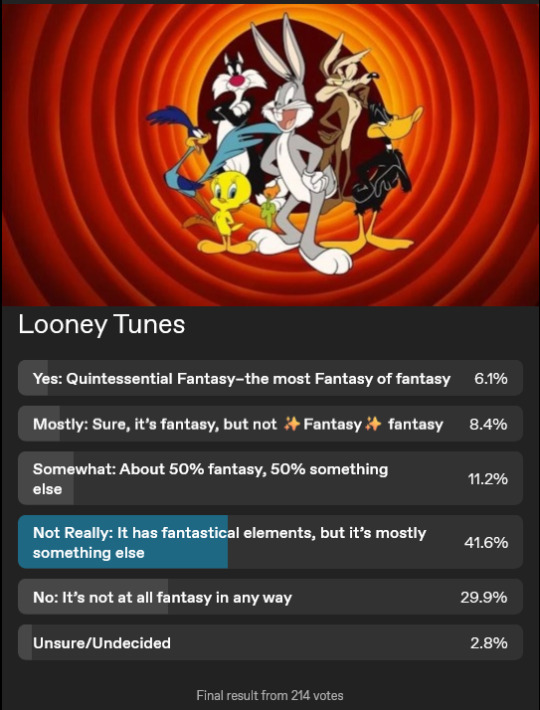

It's not surprising that Pokemon skewed towards fantasy, as it has the uplifting tone of fantasy, the journey element, and stereotypical fantasy stuff like gods and fairies (in a very Pokemon way). It's also not surprising that Looney Tunes skewed towards not fantasy, as the fantastical elements are generally used for slapstick comedy, and there doesn't tend to be a single overarching story to connect all of the episodes--it's more skit comedy than traditional fantasy.

But the results for Cars is singularly hilarious. No other work had "No: It's not at all fantasy in any way" as the top result. Even It and The Matrix are more fantasy than Cars according to Tumblr. That's objectively funny.
Cars is, arguably, more suitably described as action/adventure than fantasy, and if we replaced the cars with people, it would likely not be considered fantasy whatsoever. But it does contain the fantastic in that the cars are cars. Note that 4.4% of people did vote for it being quintessentially fantasy. My students got stuck in a raging debate on Cars for a shockingly long time, and feedback suggests that this is fan favorite work to discuss in terms of defining fantasy genre. I did not expect this when I chose it for the polls, but I'm glad I did.
Scholars have their own definition of fantasy, of course. Scholars also note many of the same criteria people used when making their own choices about what is and is not fantasy. My students did not all agree with the scholarly definition of fantasy, nor did they all agree that fantasy should be so neatly boxed into the genre. There's a lot to be said about that. I'm not going to say it here, though. I'm tired of writing, and I'm going to save the next part for Substack unless I get enough feedback to post here about it.
Let me know if you'd like the follow up (or just check out the Substack if that's your cup of tea--except there's nothing on it yet).
7 notes
·
View notes
Text


The First World War for many German artists was a catalytic experience that changed their work forever. Although Max Beckmann “only” volunteered as medical orderly and unlike e.g. Otto Dix didn’t sit tight in the trenches, the experience initiated a drastic shift in his work: where before Beckmann had dealt with historical topics in a late impressionist idiom that channeled influences from Rembrandt, Goya and early Cézanne, from 1915 onwards his style developed into what he himself coined „transcendental objectivity“, an amalgamation of Expressionism, Cubism and late medieval art. It was a direct reaction to the horrors he was confronted with as medical orderly and followed a nervous breakdown in the same year: biblical scenes, crammed into tight spaces and painted in a flat instead of spatial manner from now on are the new direction in Beckmann’s oeuvre. In brutal, almost nightmarish tableaus classical scenes like „Descent from the Cross“ and „Christ and the Sinner“ Beckmann processed the turmoils of war and the societal upheaval it triggered way beyond the end of the war.
Late last year the Neue Galerie in New York dedicated a comprehensive exhibition to Max Beckmann’s formative years between 1915 and 1925 which was accompanied by the eponymous catalogue published by Prestel. In crisp reproductions it features the paintings, drawings and lithographs presented in the exhibition but also features insightful essays by curator Olaf Peters and others. The former provides an excellent analysis of the artists’ dramatic stylistic changes and his reaction to postwar Germany with a particular focus on the disabled veterans. In the lithographic portfolio „Hell“ from 1919 he depicts the traumatized survivors and takes a biting satirical look on postwar society that also represents a link to his later Circus-themed works.
What both exhibition and catalogue quite plainly show is the incredible urgency contained in Beckmann’s works between 1915 and 1925 and with what radicality he reacted to the fault lines in postwar society. At the same time this period forms the basis for all the later works, one of the many reasons for me to warmly recommended the catalogue!
#max beckmann#art book#expressionism#modern art#new objectivity#art history#exhibition catalogue#prestel
27 notes
·
View notes
Note
Do ya ever think about Andy and Annie's dance during "Rag Dolly" and feel like watching that specific scene on loop AND sorta feeling like doing their little dance with someone at the same time 'cause hhhhh I love it and those sibs a bunch, it's just the somftest and adorablest dance to a likewise comfy song made more so by Andy's singing and I get a genuine burst of serotonin revisiting it (and lowkey that scene/song alone was what got me to watch the musical for the first time a couple years back :> if ya also have knowledge on who animated their dance or any part of Rag Dolly for that matter that'd be cool to learn about too! but I understand if that might end up being a lot to share :0)
AAAH i love love love that sequence so much!! its the cutest dance it has so much character and Andy's voice becoming so gentle and sweet right after singing No Girl's Toy is just the best thing ever. he doesn't even like Babette he's just helping his sister make a good impression.
analysis under the readmore:
what's crazy is looking through this whole book - i'm talking about The Animated Raggedy Ann & Andy - An Intimate Look at the Art of Animation Its History, Techniques, and Artists by John Canemaker (the linked version has no pictures D-:) - Rag Dolly isn't really mentioned that much, despite being essentially the main theme music.
i would love to tell you more for a fact, but i just can't say for sure who animated it, as a lot of scenes aren't credited individually.
for some songs, like Richard Williams doing No Girl's Toy, Tissa David doing Candy Hearts, Art Babbitt doing Blue, and Emery Hawkins doing Never Get Enough, the artists get a section dedicated to them and the main chunk of animation work they contributed. in the credits of the film, Art Babbitt animates the Camel, Emery Hawkins animates the Greedy, etc etc - they were generally in charge of those character-centric scenes, along with a team of inbetweeners, painters, etc.
there isn't one for Rag Dolly, since it's relatively short and bounces between characters. so basically TAKE ALL OF THIS WITH A GRAIN OF SALT!!!
the ONLY expertise i have is that 1. ive flipped thru john canemaker's book and 2. i love this movie so much
what i CAN do is make wild guesses ^_^ and this first little verse as Ann fidgets with her dress and apron just SCREAMS Tissa David to me. here's a pose from that sequence side-by-side with one of her famous (and one of my favourite) Raggedy Ann drawings.
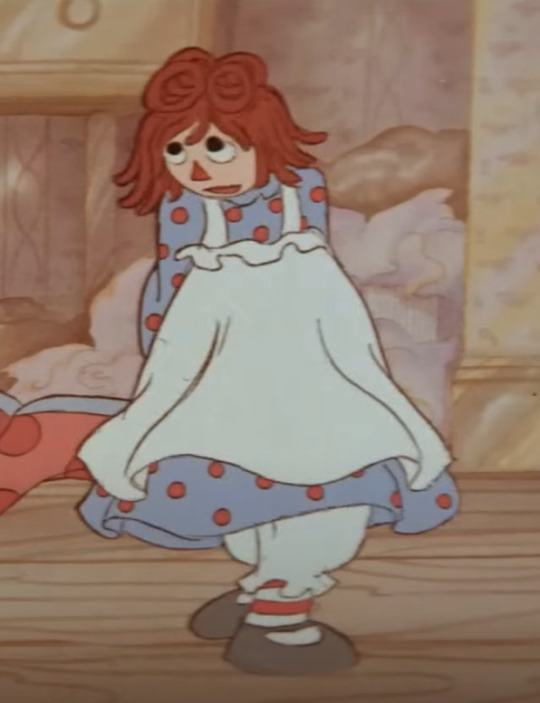

here's something she notes about Ann's first action sequence of falling off the chair (she was set to work on candy hearts before anything else, to really get to know the characters):

and here's a fantastically convenient gifset from Rag Dolly. EVERYTHING!!! her hair falling in her face, the movement of the fabric, the wonderful sense of timing. also note the lack of eyelashes, which isnt exclusive to one artist or anything, but does pop up in David's drawings:

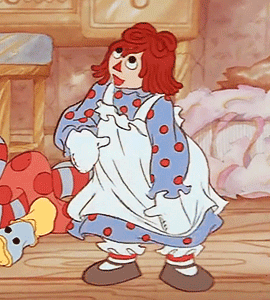
now to go on a tangent about an artist who could well have worked on that scene, and whom i wish there was some more info about!!!
"The only thing that Disney never understood is that to animate girls, one must be a girl!" - Tissa David believed (along with pretty much the rest of the team) that herself and Chrystal Russell (whose work is woefully sparse in the book but very much present in the movie) were the best animators of 'little Annie'. she also worked on Fern Gully; you can find her credits under her married name, Chrystal Klabunde! she supported Tissa as the primary actor for Raggedy Ann, and her style appears as this distinctive, adorable, muppet-y look throughout the film. these pics are examples of, if not her own drawings, then her stylistic influence in these scenes:

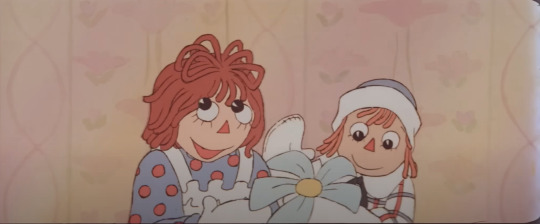
she's credited as animating the playroom dolls, but you can notice her influence in Annie come through from the beginning ('I Look, and What Do I See?') to the end ('Home') of the whole thing. like i said, the credits are never too specific, but if i had to GUESS, then this looks like her stuff. we also know for a fact she worked on the first song because of this lovely set of drawings in the book!
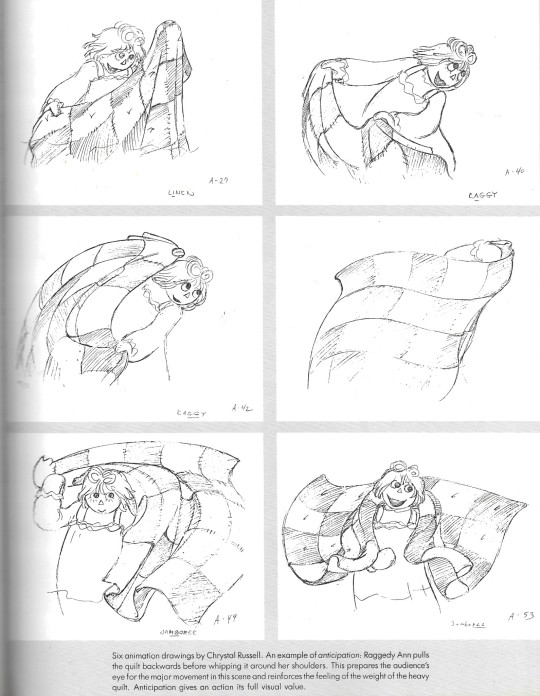
here's the sweetest photo of Didi Conn (Ann's voice) and Chrystal together with some clean-up sheets of a shot right before Rag Dolly - when Ann introduces herself to Babette, 'my name is Raggedy Ann, and this is my brother, Raggedy Andy,' (i still can't confirm whether they're her drawings but i wouldn't be surprised!):


anyway tl;dr: i have no way of knowing for sure who was in charge of it, and no doubt a whole team of artists were involved, (and i'm in no way trying to discredit anyone if i'm wrong) but my best guess is you can thank Tissa David for the first part, and Chrystal Russell (now Chrystal Klabunde) for their dance together - the animation changes subtley between those shots. i wish i had more artists/resources to look at, or god forbid a full breakdown of that scene, but at this point i would bet money on David's part in Annie's little introduction.
also some final appreciation for this silly slide to the ground that Andy finishes with:
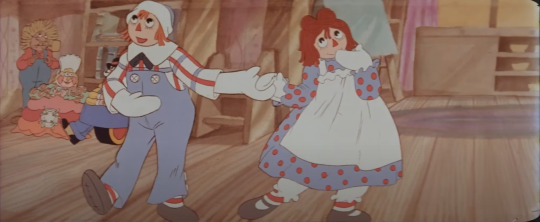

anyway i'm SO sorry for going on such a long rant in response to this lovely ask!! and i'm sorry it took so long! it took so long, in fact, that i was actually accepted into university halfway through writing it the other day! so thank you!
i had so much fun playing amateur detective so double thank you!!! again i'm probably wrong about ALL of this but it was a blast to reread sections of the book and rewatch different bits of the movie to sleuth around for clues. i hope whatever i have come up with is of some interest to you, and i hope someone learned something about the wonderful artists behind this movie :-D
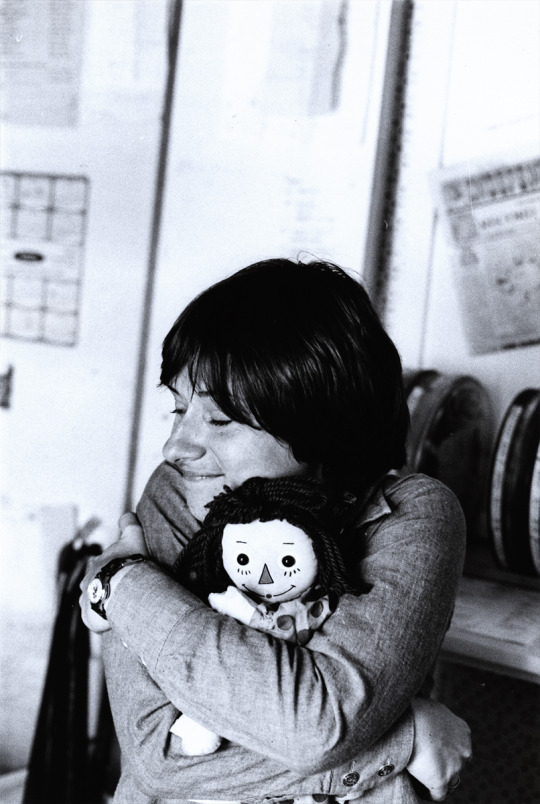
chrystal and raggedy ann ^_^
#raggedy ann#i may be crazy! i may be crazy!#ask#raggedy ann & andy: a musical adventure#tissa david#chrystal russell#john canemaker#animation#art
47 notes
·
View notes
Note
Hi! I love your art style it's like. Breathtaking. And your hcs on barry are some of my favourites of all time?
What do you think of "The Ballad of Barry Allen by Jim's Big Ego as an analysis of Barry's character?
are you asking or are you telling me 🤨 lol THANK YOU i put all my headcanon power into him <3
for the ballad, i love their song stress, and this isn’t bad at all as far as fansongs go. but there’s a reason i don’t include it in my barry playlist, and it’s ultimately bc it doesn’t fit my narrative haha
the song was made in 2003 and i haven’t read many comics before then, so idk how well it aligns w barry’s characterization prior to flashpoint, but i’m basing my playlist off post-flashpoint, so that’s where a lot of the differences will lie
for starters, the song only includes one half of barry’s relationship to his superspeed, and it’s important to me that a barry interpretation includes both sides of that coin. instead, it’s playing on the idea of the dark side of the hero fantasy, an inherently optimistic genre. which, fair, being a superhero sounds like a nightmare, but that angle is less novel to me when that’s the extent of the analysis (and i’m a little over the whole “i hate being a superhero” storyline in general, personally). the song is basically abt how much it would suck to have superspeed bc the world slows to a crawl and you’re left behind bc no one else can keep up w you. and it’s true, that is a very real setback! especially for someone like barry who’s already prone to self-isolation and time management issues! but what does the song actually have to say abt him as a character?
the thing is, barry isn’t a “i wish i wasn’t a hero” kind of guy. he’s a “could i be so strong [to give up the flash]? or do i love the thrill of these powers too much?” kind of guy. he’s a “knowing what i know now… if i could go back in time… maybe i would’ve been somewhere else the day lightning struck my lab and electrified those chemicals, ready and willing to forfeit a life of dodging deathtraps and battling villains… who am i kidding? there’s no going back. no do-overs. like everyone else, superheroes can only follow the path destiny has laid out for them, whatever lies ahead.” kind of guy. yes, barry is caged by his superspeed, but it would be misleading to not present it first and foremost as the very thing that frees him. it’s a double-edged sword that gives him purpose, and that freedom in obligation is what motivates him to keep going. as a wise man once said, “all you can do is go forward.” (“thanks.” “superman is pretty smart isn’t he.” “hm.”)
i think the real kicker for me was this lyric: “i’ve got time to think about the past… how my life was so exciting before i got this way.” my sincerest apologies to mr. allen, but he does not feel complete to me without his mother’s death or his father’s false imprisonment. this backstory contextualizes everything for me. his life was NOT exciting before his superspeed, it was lonely and full of escapism, either in his sci-fi/comics or his dedication to finding justice. i am of the belief that barry didn’t truly start living until he got his superspeed, over 2 decades of waiting around before he rly understood freedom and what it meant to live for himself. i get what they’re trying to do here, but this is what i mean when i say it feels like the song characterizes barry around the concept of his speed rather than how barry’s speed defines him as a person
ik i can’t expect a 4min song to include every aspect of a character’s timeline/development/nuance (esp before some of that even existed lol), but my issue isn’t that it doesn’t cover enough ground—it’s not bad that they had a theme and stuck by it, i actually love the lyrics from a speedster perspective. my issue is that i don’t think this is a good framing for barry’s character as a whole. for all his regrets and suffering, barry is optimistic to the point of denial. choosing this to be The theme to represent barry just. doesn’t feel like barry to me. it’s more like barry is the placeholder subject as an excuse to sing abt superspeed
if this was somehow less overtly a “BARRY ALLEN FANSONG” and maybe more metaphorical or even non-fandom, then it would be a dif situation and i might have dif opinions. at the end of the day, this has more to do w my pickiness than the quality of the song, and the fact that it even exists is so exciting for me as a barry allen enjoyer first, human second. but if you’re going to call smth a character study, i Will be getting my hopes up
#barry allen#the flash#dc#danswers#danbles#i’ve never had to put this into coherent thought before usually i’m just being a hater unprompted in my friends’ dms LOL#which i think should emphasize that my opinions say more abt me than this song or even barry#but ty for the kind words + ask! this was rly fun to rattle around in my brain#i love having strong opinions abt things that don’t matter 😋
20 notes
·
View notes
Text
REVEALED: Obamas WERE On Martha's Vineyard When Chef Mysteriously Drowned in their POND: 8 feet of water
In a turn of events, it has been confirmed that former President Barack Obama and his wife, Michelle Obama, were indeed present on Martha’s Vineyard when their personal chef, Tafari Campbell, tragically drowned under mysterious circumstances. The Obamas, who own a massive house on the island, initially reported through their office that they were not at the residence when the incident occurred.
However, the narrative has since been changed, stating that while they were on the island, they were not at their residence at the time of Campbell’s unfortunate demise.
Campbell, 45, was discovered dead on Monday by divers after he went missing in the Edgartown Great Pond, Massachusetts. Campbell had been paddle boarding with another individual around 7:40 pm on Sunday. Eyewitnesses reported that he was dressed entirely in black and was not wearing a life preserver, a detail that has added to the mystery surrounding his death.
The DailyMail wrote:
Initially, the Obamas’ office said they were not home.
Their office clarified on Monday that they were on the island, just not at the residence when Campbell drowned.
The circumstances leading to Campbell’s death remain unclear, and an autopsy is expected to take place. As part of the investigation, a toxicology analysis will also be conducted, which is a standard procedure in drowning cases.
Campbell had a long-standing relationship with the Obama family. He served as a sous chef at the White House during the Obama administration and continued to work privately for the family after they left office.
Adding another layer to the mystery surrounding Campbell’s death is the fact that he had taken swimming lessons as recently as 2019. Reports have led to further speculation and questions about the circumstances of his death.
Campbell’s Instagram ‘Fitness’ highlight showed his dedication to maintaining his health, showcasing him swimming backstroke, freestyle swimming, logging a 40-minute swim workout on his Apple watch, and even bench pressing 315 pounds.
WATCH:
Campbell’s wife, Sherise, released a heartfelt statement on Instagram mourning the loss of her husband. She wrote, “My heart is broken. My life and our family’s life is forever changed. Please pray for me and our families as I deal with the loss of my husband.” The couple were parents to twin 19-year-old sons.
The staff at Edgartown Meat and Fish Market, where Campbell was a regular, also paid tribute to the chef, whom they remembered as a ‘wonderful guy’. “We saw him last week, he was such a nice and happy guy,” one staff member shared, adding that Campbell had been a customer for a few years and would often chat about what he was cooking.
Barack Obama's Chicago Man Country Friends:
November 17, 2007 Larry Bland shot and killed in his own home
December 24, 2007 Donald Young shot and killed execution style in his own apartment
December 26, 2007 Nate Spencer died in Chicago Hospital (AIDS)
November 14, 2011 Larry Sinclair, Obama's CHICAGO 1999 Bathhouse & cocaine prostitute involved in hit and run car incident
In 2008 Beau Biden & Joe Biden arranged to have Sinclair arrested for telling the Washington, DC National Press Club about his gay love affair and cocaine use with Senator Obama.
#barack obama#michelle obama#martha's vineyard#chef death#larry sinclair#larry sinclair died#norma jean young's son was murdered#donald young#larry bland#Nate Spencer#The Program#Trinity Church Chicago#Down Low Club at Trinity#Jeremiah Wright
75 notes
·
View notes
Text
oh shit i forgot here's another one, this time its an old neal caffrey analysis rant (this one fueled by insomnia, and written much earlier into my first watch of white collar - i think early season 3??):
im gonna be weird about white collar but the thing is so many people are weird about white collar in the wrong direction
like woobifying neal to hell and back or inventing whole new personalities for el or . i don’t even know how to describe what they do to peter
like the thing about neal is he Is a magpie he’s just a surprisingly loyal one, he flits from shiny thing to person to ideal, sure, but certain classes of ppl can fully hold his attention
peter holds his attention bc he is good as in skilled (it’s borderline canon that no one else can catch him, or even really come close), and extremely principled w a cunning streak which neal basically approaches as like. a puzzle box, bc like none of their principles line up so he’s curious how the apparent closed system rube goldberg machine of his morals work LOL
then it becomes a dedication through loyalty, in that peter sticks his neck out multiple times due to faith in neal, and neal is EXTREMELY weak to loyalty/consistency (gestures at the mess of his childhood)
and due to generally low self image (morals wise, he kind of thinks he sucks? like he’s competent and cool and charming and everything, but he also tends to consider himself a nuisance, w how he’s disruptive to ‘normal’ / ‘good’ people) that dedication can become disproportionate
we see through kate (and later, adler) that the easiest way to con neal/get him acting against his own self interest IS to cultivate that loyalty
there’s an easy archetype to it, even, in that u present him with a competent, smart individual (bonus points if they’re a conventionally attractive woman), but have her off limits in some way (uninterested, taken, stand off ish, whatever), activate his thief urge to ‘take’ what he wants, then when they are friends/partners whatever, his inadvertent guilt over like. corrupting/endangering this person/tricking them about who he ‘really’ is will loop around into VERY strong loyalty, and a commitment to being whatever they want him to be x2, bc he Cannot handle being left behind LMAO
peter simultaneously feeds into + challenges this framework, bc he clearly has the least biased opinion about who neal is, even though he’s still wrong about a lot of things. and beyond that, he REALLY likes neal, thinks he’s interesting and funny, but at the start of the show can’t deal with even 0.01% of his chaotic neutral methods
WHICH IN TURN!! actually breaks through some of Neal’s shit bc:
peter picked him out of prison before neal had changed at all
he essentially sees his role, from as early as ep 1, as tactically breaking the law where peter can’t/won’t, in ways that help them close the case faster
after peter (more or less) gives a thumbs up the first time he does this, neals puzzle box brain goes ‘oh?? morally grey bestie??? CRIME BESTIE????’ and now he’s trying to ‘solve’ peter’s moral code
this is actually almost in complete opposition to elizabeth, who is compete open and clear about her affection and friendship w him basically since they meet, and apparently has no prerequisites for it. which, again, pointing to the low self esteem, triggers the ‘oh god what have i done to deserve this i haven’t even CONNED her yet’ so he’s low key more invested in + comitted to elizabeth in a specific. 'i want to be on good terms w this person' targeted way than he initially was w peter (since their mutual obsession manifests so fucking frequently as 'what, you're gonna hit me? you're gonna hit me with that big bat? better make it hurt. better kill me in one shot!' style antagonism)
HENCE the constant check ins w their relationship, reminding peter about anniversaries and dinner times etc, though that’s also due to a general fascination he has w stability + permanence
we learn in s2 he was seriously considering proposing to kate, and that he genuinely wanted to take the ‘true love’ way out of the conman life, even though he wasn’t quite sure whether it would stick, hence we see a lot in s2 his fascination w peter + els marriage, along with june (crime aunty <3)‘s relationship w her passed husband
a lot of his dedication to peter circa s2 is, by my reckoning, explicitly because peter is so determined to stick with Neal, and doesn’t give up on him/their deal even when it would be entirely reasonable (neal admits to crimes, gets put back in prison, constantly breaks rules and goes looking for kate) which is like. neal HATES being trapped, but he also REALLY values consistency + competency
hence the complexes, y'know?
#wc#white collar#can you tell im procrastinating uni work. im gonna get a functional draft of this assignment done and then i'll reward myself by posting my#inconsolable wailing circa elizabeth's kidnapped arc
37 notes
·
View notes
Note
Howdy howdy! First I just wanted to say; Congrats on 10,000 followers! You deserve it!! Your hard work, creativity and dedication are so present in everything you do, and it's so inspiring. I wish you lots of luck in your future projects ☺️☺️
May I please ask for a romantic ship for The Boys?
I'm 22, non-binary (AFAB, if that matters) pansexual/romantic, and polyamorous (no preference for gender)
General personality stuff:
MBTI is INFP
Ennegram types 2, 4 and 8
Zodiac: Taurus sun, pieces moon and rising
Hogwarts house- Hufflepuff
I'm in college- Women and Gender Studies major with a Queer Studies minor
My goal is to go into harm reduction/community + advocacy work : )
Dreams for the future; ideally a semi-active lifestyle where I can pursue my interests- I'd like to have a home gym, a gaming set up and a crafting room one day. The work I'm going into will likely be very emotionally draining so ideally I'd have the free time to relax/recharge by playing games, doing art, and hanging out with my partner. Something I'd really love to do one day is get really high and go into an aquarium or planetarium
Favorite places I've been; Costa Rica, Italy, Santa Cruz/Monterey (specifically the boardwalk and aquarium)- I'd love to visit France and Japan someday
Pet peeves; I strongly dislike when people have an inflated ego and genuinely don't care about/respect others. Hate capitalism/pro-capitalist arguments and People who don't recognize larger underlying issues or who choose to ignore key information when looking at an issue
I hate when people are condescending and cruel. I get super annoyed with people who don't follow road safety or who are just rude drivers
Appearance: I'm 5'3, chubby, and kinda muscular. I have lots of scars on arms, chest, and legs. I have mid-length brown hair that I usually wear in a half-up style. I like dying it but bc I'm working right now, the ends are just bleached. I have dark brown eyes, some freckles/moles/scars littered across my face, and round cheeks. Fashion consists of graphic tees (with puns, memes, and trippy art) and jeans or shorts/cargo pants. I'll wear lots of different kinds of jewelry, including fun earrings, chains, and chokers. My style is casual/comfortable. I put effort in, but prioritize comfort lol
Hobbies/likes- theatre/acting, going to the gym, roller skating, playing video games, listening to music (and singing along.. Badly), smoking weed, watching TV shows and movies, drawing/coloring hanging out with friends, Writing, reading, going to museums/amusement parks, taking care of/watching animals, making bracelets/jewelry, surfing/swimming
intellectual interests; extistentialism, law/politics, current event/media analysis, anything to do with space or the ocean, animals/environmentalism, studying languages
Positive traits: my friends have told me that I'm smart, funny/goofy, sarcastic, polite, thoughtful, strong, patient, trusting/trustworthy, empathetic and compassionate. My friends generally come to me for advice and I've been told I'm a good listener. I also like make myself useful (doing dishes, wiping down counters, laundry, etc) I'm passionate and very excitable and it makes me pretty talkative (when I want to be). Sociability depends on my mood. Sometimes I sit back and enjoy group dynamics, other times I participate more in conversation
Negative traits: I'm pretty self conscious/ insecure, and indecisive because of it. I definitely have a tendency to be envious. Bad habit of taking stuff personally and dwelling on issues that I should let go. can get annoyed/frustrated easily, especially if I'm overstimulated. I'm also jumpy and gullible. Communication is very important to me in all my relationships, but when I get depressed, I tend to isolate.
I show my love through acts of service and prefer words of affirmation. I enjoy doing things for my loved ones and making sure they can relax, feel safe, and be happy. I'm not exactly sure how to describe my type so I'll list a couple characters I simp for lol- Wolfwood (trigun), Aki (chainsaw man), Percy (Vox Machina), Levi (attack on Titan); I guess how I'd describe them is- sarcastic, closed off but vulnerable, funny, brooding, obsessive, sensitive
Misc stuff
- Right now, some of my favorite media includes The Boys, Trigun, The Office, Gravity Falls, Rick and Morty, Adventure Time, Breaking Bad, Hollow Knight and Arcane.
- Games I usually play include Overwatch, League (I'm ashamed), Hollow Knight, Pokemon and Harvest Moon
- Currently Attempting to get through a book called The God Problem. Super interesting but goddamm it's thick
- I collect a lot of stuff. I have a Ton of comfort items- my posters, stuffed animals, collectible figures, etc.
- When I first meet people, I'm overly formal and will crack a few jokes, but once I'm familiar with someone, I cuss a lot and enjoy playful teasing, but I always encourage to set boundaries if they need to.
- I'm a big over thinker. I can be pretty independent and self sufficient (sometimes) but I'm also very very insecure and doubt myself a lot. I've got lots of vocal stims and am pretty fidgety.
- I listen to a lot of different kinds of music but I think the main genres I listen to are indie and alt rock
- some of my favorite artists include khai dreams, Hozier, Mitski, Maneskin, Queen, and The Weekend, and I really enjoy musical/cartoon scores and soundtracks (especially Adventure Time and Steven Universe)
- Fave songs right now are Stress Relief (late night drive home), Good Luck Babe (chappel roan), Don't Look Back (kotomi, Ryan elder), First Time (Hozier), and Die For You (the weekend)
I did my best to flow along with the rules you laid out- hopefully I didn't miss anything- I apologize if I did. I know this is really long, so I apologize if it's overwhelming. Please don't feel pressured to answer. Take care! 💛
-thatstonedwriter

Marvin loves your intelligence. Whether you're talking about politics and law or the best way to undermine Vought, he's absolutely blown away by your thought process. He's always bragging about how smart you are to anyone who'd listen
Everyone else you work with (maybe there are one or two exceptions) tends to think about what they want and act on it compulsively. You're level headed, thoughtful, something he wasn't used to at first, but instantly fell for
You and Marvin are constantly doing things to make each others lives easier. You might wash the dishes one night while he folds the laundry. Showing up at the office with coffee and something sweet when he pulls an all-nighter. Small gestures that mean so much and that show your love
Dealing with Butcher means being told hurtful things and being expected to brush it off like it's nothing. Knowing it'll hurt you deeply, Marvin makes it clear to him (in private of course) that you're off limits. He can be an a--hole to him all he wants, but he draws the line when it comes to you, no exceptions
Marvin definitely takes inventory of all the things you collect (posters, trinkets, etc.) and, no matter what, finds something to add to it. He finds tons of small, cute things that remind him of you. They're left on your desk or on the counter in the kitchen where he knows you'll see. Usually there's a little note attached in his pristine handwriting, always with a heart by his name as if you didn't know it was him who'd left it there
I hope you like it my love!!!! :D Xoxoxo💜💜💜💜
Want to request a ship?
6 notes
·
View notes
Text
Masterlist/Navigation
Finally took the time to sort out my written works. Hope this helps out some of you navigate through my works!
AO3 Link: 💜
Multi-chaptered stories:
Black Tea is Fine- (Angst, slow burn, love triangles) Levi was the new janitor at Paradis High. He thought that rowdy teenage brats would be the worst part of the job, until he met the school's eccentric chemistry teacher Hange Zoe. His peaceful and quiet afternoons within the building were soon challenged by her persistent invitations for some tea in her classroom.
Unexpected Co-Parents- (Fluff, co-parenting, unexpected meetings) Levi Ackerman had been living in the big city of Sina for a while now as a corporal worker, finding peace in the little solitude he got from the bustling and lively city life. His peaceful days however, are numbered as he unexpectedly finds himself becoming co-parents with an eccentric florist he just met.
Short HC:
Four-Eyes- (Canonverse, post-war, reminiscence, slight angst) Armin gifts the ex-corporal with a gift that belonged to Hange. The present bringing newfound comfort and memories to resurface years after the war.
The First Kiss- (Canonverse, rumbling mention, post-war) How their first kiss happened and how Levi remembers it after the war.
The Best Friends Lover Trope- (Prewar, Veteran era, fluff) Levi and Hange's love language and how they express their feelings for each other. How they'd be in a relationship
Drabbles:
Tied Up in Marley- (Canonverse, semi-sad, fluffy ending) Follows after the event of the SC making it to Marley. Levi finds it difficult to adjust to the cultural differences in the enemy territory. Mainly the clothing style and the overly complicated accessory called a tie. Hange, however, helps him figure it out.
The First Night- (Canonverse, mainly fluffy, mention of death) After Furlan and Isabel's death, Levi struggles to deal with the loss of his best friends. Hange having noticed the man's shift in attitude, decided to help him get through his grief, and in the process creating a special bond between them.
Happy Birthday, Four-Eyes- (Canonverse. Veteran Corps. Fluffy. Enemies to friends) The corps was getting ready to celebrate Hange Zoe's birthday, but Levi, the one person who didn't get along with her, ends up getting involved in the celebrations anyways.
Levihan as a Couple in Modern AU- (Modern AU, strangers to friends to lovers, fluff, slight angst, domestic life) From an ask sent in. Explores the relationship of Levi and Hange as a couple in modern life.
Previews of Next Works:
List of Previews
Captured at First Glance, Immortalized at a Second- (Angst, missed love, slow burn, missed opportunity) Levi Ackerman, a renounced photographer had been friends with ecologist Hange since they were young. And that was the only way he could ever see her as despite Hange having confessed her love for him during their high school years. Unfortunately, love isn't always reciprocated, and instead of returning his childhood friend's sentiments, Levi ends up falling for her half-sister Petra instead. As separation and new life events lead them into different life paths during their teenage years, severing their ties with each other along they way, they end up meeting once again as adults for Mike and Nanaba's wedding. Where Levi is suddenly confronted with the possibility of having lost on the love of his life when he realizes he'd been in love with Hange all along.
Levihan Promp Ideas
Posts:
Levihan:
Analysis:
💜Shared Jacket
💜Levihan X Aruani
💜Levihan How it Started vs. How it Ended
💜Levihan Hellos in No Regret vs. Last Goodbyes in Ch. 132
💜Levihan Opposites Attract
💜Hange's Importance and Influence on Levi's Life
💜Levi's Scars are the only Physical Reminder Levi Has Left of Her
💜Dedicate Your Heart and Levihan Being Almost Married
💜Levihan Actors Wearing Original Scouts Uniform
💜 Levi's Gaze Towards Hange Over the Years
💜 Levihan and Hanako/Kabakura (Wotakoi) as Each Other in Different Fonts
💜 Levi Brave Order Birthday Wish for Hange
💜 Levihan and their Adopted Kids
Random Thoughts:
💚 One-Eyed Junior High Hange and Levi
💚 Levihan X Collaborations that Call Levihan Canon
💚 Levihan Sharing a Lollipop on a Date in Marley
💚 Levihan Sharing Tea Official Illustrations
💚 Levihan X Re:SHAZAM Collab
💚 Levihan Sharing Everything
💚 Levihan X Eremika Parallels
💚 Levihan in Eremika Steam Punk Outfit Edit
💚 Levi Constantly Losing the Important People in His Life
AoT X Collaborations:
⚔️ EEO Sherlock and Phantom of the Opera Style Collab
⚔️ Levihan X RE:SHAZAM Collab
⚔️ Flex Japan Tie and Suits Collab
⚔️ NOBIACE Levi Collab Illustration
⚔️ Charalog Chibi Collab
⚔️ Marakuji Circus Collab
⚔️ Junior High Umbrella Tags
⚔️ Animate Marley Collab 2
⚔️ AoT Sleepy Collab Compilation
⚔️ Chibi Sleep Collab
⚔️ Eren, Erwin, Hange, Levi X NOBIACE Collab
⚔️ Ackermans New Skins in Brave Order
⚔️ AoT X Roll Ice Cream Factory Collaboration
⚔️ BellHouse Shop Collab
AoT Random Posts:
AoT Pairs that Lost Their Significant Halves and their Love Tropes
Sauna Official and Fanart Illustration
AoT Characters Seen as Actors by Isayama
AoT Tarot Merch Sets Meanings and Explanation (In Depth)
#levihan#levihan masterlist#masterlist#levi x hange#levi x hanji#hange zoe#levi ackerman#levihan ff#levihan fanfiction
117 notes
·
View notes
Text
If you believe in nothing, you will achieve nothing
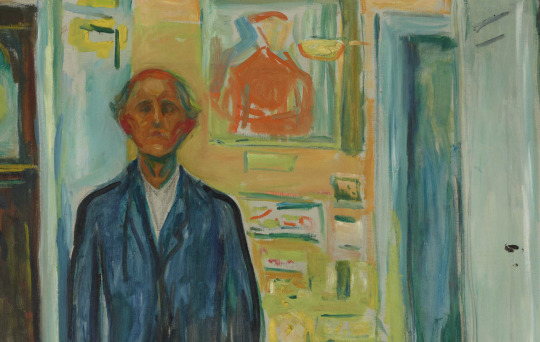
Andrea Long Chu has a problem. She and her acolytes presently enjoy dictatorial control over every discourse that falls to the left of Fox News. They have convinced the world that speech is inherently violent and therefore a dedication to free speech is a precondition of fascism, if not outright genocide. Every decent person must agree with every thing they say, no matter how deranged or implausible. And so if a random person, for example, says that sexual dimorphism exists or that maybe cosmetic hysterectomies shouldn't be the first response to teenage mental health issues, that person has committed a severe act of violence and must be silenced.
But, oh no, it turns out that Chu and her cohort have found themselves outgunned on the topic of Israel-Palestine. The same left that has gleefully silenced all improper discussions of culture war issues for the last decade is now seeing their exact same tactics being used to silence any criticism of Israel's ongoing genocide. You can't even do something as anodyne as expressing support for a ceasefire without making a Jewish Yale student feel unsafe, and since speech is violence and feeling unsafe is even more of a genocide than an actual genocide I'm sorry, you were bad and unvalid and you must silenced. Them's the rules.
Chu attempts to reconcile these two, very sad realities in a recent piece for New York Magazine titled "The Free Speech Debate is a Trap." The essay is staggeringly moronic, even by Chu's august standards. I had to read it twice just to make sure I wasn't understanding it unfairly.
My readers seem like decent people. I find no joy in subjecting them to crap like this. But a deep dive into Chu's essay is necessary because it confirms the value of free speech on two fronts: 1) it shows why nothing short of a doctrinaire support of the first amendment can allow for the dissemination of opinions that dissent against the consensus of the permanent war state, and, 2) it demonstrates how an opposition to free speech leads to the proliferation of braindead analysis among supposed leftists.
Let us begin:
As is her wont, Chu writes in an obfuscatory style. She belabors simple points to weaken the reader's attention, so that when she sneaks in observations that are insane or otherwise very stupid we're less likely to notice.
She starts with a description of herself, another writer, and the whole staff of a poetry center being deplatformed for expressing their support of the Palestinian cause. This is, obviously, an injustice. But rather than taking the fascist's way out and deciding that maybe this free speech thing is actually worth pursuing, Chu explains that the incident actually strengthened her resolve against the free and protected exchange of ideas. Because, naturally, anything else would render her a hypocrite, and then she wouldn't be able to silence people for dissenting against gender bullshit:
Now it’s true: A left that supports the deplatforming of transphobes but opposes the deplatforming of anti-Zionists cannot justify itself by appealing to free speech — nor should it. For the liberal, freedom of speech is a deliberately empty principle. It allows a liberal institution to mediate peacefully between differing political views without any (apparent) reference to the content of those views — all while quietly promoting its own views under the banner of neutrality. The left can do better.
Now, here it's very important to note the degree to which the concept of transphobia has been expanded in recent years, thanks in no small part to the work of Chu and her allies in media and academe. The concept once meant something like "a hatred of trans and/or gender non-conforming people," which is bad. But now it's expanded to include things like recognizing that males and females have different athletic abilities, expressing concern with the thought of male sex offenders being housed in women's prisons, the refusal of female service workers to perform intimate procedures on natal males, or even simply using words like "male" and "female." This type of extreme narrative control simply could not persist in a discourse that wasn't very broken, or among people who did not regard the aggressive policing of speech as a paramount ideal. Like the rest of the identitarians who now control what passes for the American Left, Chu is very unabashedly pro-censorship.
Strip down the blandishments and you'll find her point is simple: free speech is bad, because it allows people to say things that may discredit her. Only instead of admitting to being discredited, she shall claim that speech itself in an act of violence, because after all if she's discredited that means violence has been inflicted upon her. Herself and other people who believe everything she believes should be anointed the gatekeepers of what does or does not constitute acceptable speech. Those who break from their dictates must be shunted from the public sphere and suffer professional consequences.
The type of nihilism endorsed by Chu is only advantageous to those whose beliefs benefit the empowered. And, at the end of the day, the people who run most every left-liberal institution (including the Democratic party) are resolutely in favor of Israel's genocide. Some of them take genuine pleasure in watching Palestinians die; others were taped fucking children on a sex island and cannot upset their blackmailers; and the bulk of them are mortified by the prospect of being labeled some kind of -ist or -phobe, as they know full well--thanks, again, to the efforts of Chu and her cohort--that they would not be able to proffer any defense against such accusations, regardless of how stupid they may be.
There is no way to reconcile this situation within the boundaries set by left identitiarisn. None. You can either support free speech as an abstract principle and allow unpopular and inconvenient speech to proliferate without punishment, or you can endorse a society where the acceptability of speech is determined by the desires of the warmongering sociopaths who run the world. It's one or the other. There are no other options.
I don't think anything I've written so far is especially complicated, or even controversial. These are the sort of observations I would have easily grasped in middle school. But, oh, here's where the obfuscation sets in, where Chu demonstrates her Pulitzer Prize-winning skill of making reactionary bullshit sound left-ish.
She starts with the well-worn trope of arguing that today's speech debates aren't really about free speech because the first amendment only applies to, like, the government:
It is worth remembering the vast majority of what we call free-speech issues have little basis in the First Amendment, which only forbids the abridgment of speech by the government, not private organizations like magazines, cultural centers, or Hollywood production companies. In most states, for instance, it is perfectly legal for employers to fire workers for speech, as a Westchester synagogue did last year after a teacher wrote an anti-Zionist blog post. So when advocates talk of freedom of speech, they are usually referring neither to the Constitution nor to statutory law but to a set of civil norms imagined to promote the health of the republic but which cannot be directly enforced by the government.
As a matter of simple fact, this is wrong. At least 32 of our 50 states require potential government employees to sign some sort of loyalty oath to Israel before they are allowed to receive state jobs. Compelled speech in support of zionist genocide--or, at least, the promise to never criticize said genocide--is enforced by the government. This is very literally a first amendment issue.
But, I will concede, the support of free speech largely redounds to a set of civil norms--the same as how we don't go around slashing other people's tires or puking in our neighbor's mailboxes not strictly because it's illegal to do so, but out of a sense of shared civic duty. Even if we can't articulate exactly why, we just sense that it would be bad to abandon our principles to a degree where we did or tolerated that sort of stuff.
These unspoken compacts are essential for the existence of any human society. And probably any animal society. And, shit, this probably applies to plants and bacteria, too. But the persistence of these compacts pisses off people like Chu because such compacts can, at times, present a threat to their capacity as the sovereign overseers of what is or is not acceptable. If judgments were deferred to science or empiricism or any other existing form of adjudicating correctness and decency, all of a sudden Chu wouldn't be a very smart intellectual, and we cannot have that.
Chu's... her... discussion of this? I hate to call it a "response," because an actual response would require some degree of honesty. But, uhh, the way she addresses this is to point out that free speech is actually, like, just a fiction, mannnnn...
While it is true that left-wing ideas have flourished in the humanities and, to a lesser extent, the social sciences — the result of the retreat of post-1968 social movements into the academy — the big private universities remain in the business of business, their endowments tied up in fossil fuels, big tech, and the prison-industrial complex and their purses fattened by wealthy donors who expect influence in return. After a letter was released at Harvard that blamed “all unfolding violence” on the Israeli government, the billionaire hedge-fund manager Bill Ackman, apparently speaking for his fellow CEOs, demanded that the school publish the rosters of the student groups who had signed the letter “so as to insure [sic] that none of us inadvertently hire any of their members.” The implicit understanding here was that elite private universities funnel their graduates into the nation’s highest positions of power and influence — including Congress itself — and that this pipeline must not be polluted by ideas that its previous beneficiaries find morally despicable or politically disadvantageous. The House hearing itself came chillingly close to a direct attempt by the federal government to materially intervene in the composition of the incipient professional class through, as more than one Republican suggested, the expulsion of student protesters.
Yes, indeed, speech has always been limited by the sovereign. Go back and read Locke and Bacon, see how much they hem and haw about their love of the Queen. Point to any of the hundreds or thousands of socialists who found themselves jailed in these United States for criticizing our involvement in the first World War. That's all true. But none of these facts negate the value and utility of free speech as an ideal.
If you have no principles, if your only goal is a naked quest for power, you will eventually encounter someone more empowered whose desires run counter to your own. Then you will fail, as you will have no recourse to do anything but fail. Without ideals, there is no path forward. Without decency, there is no hope. If the battle over the continuation of a genocide redounds to nothing less vulgar than two sides claiming righteousness by din of their own existence, the side that owns all the guns and media organizations is going to win.
But there's no room for such realizations within today's left, of whom Chu is a very sad but fitting embodiment. She is immensely successful not because of talent or intelligence or decency but because she manifests the perfect set of identity markers. If she were not physically hideous and/or a manipulative sociopath, she'd be a nobody. She thrives within our broken discourse only because her enablers fear her, and that fear is born of nothing more than pity. She cannot afford the existence of principles, as that would threaten her exalted status. And she is demanding that all the rest of us abandon every last sliver of hope to make sure she and friends remain in charge.
15 notes
·
View notes
Text
New era
𖤐Hello everyone Kuronians𖤐
Since the 15th anniversary, I have noticed that Yanuzza's style has changed quite markedly. I'm not talking about the drawing style, rather the thinking behind every illustration or project she has done since the anniversary.
The beginning era
From 2008 to 2019, the illustrations in the magazine were beautiful. Just beautiful.They didn't tell a story, and the first ones in particular, were bare, without soul.There were of course some exceptions (also because change doesn't happen overnight) such as the 2012 magazine where we were first introduced to Soma with typical Indian wedding accessories, accessories that we later revisited. I brought this wedding theory to my Italian profile, so if you're interested in reading it, let me know I'll bring it here too!
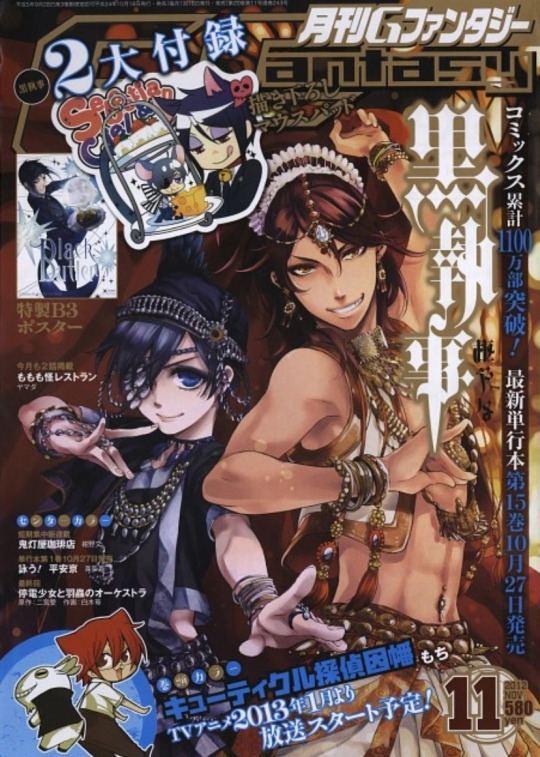
The 2013 revue is also very interesting, not only because of the washed-out colours, but also because she starts introducing flowers: ornaments that she will make her own from the 15th.Furthermore, looking at Undertaker's figure, one could say that he tried to give us a hint of a spoiler that year.

The dark era
In 2014, he experimented with a lot of dark colours, resulting in illustrations with a more serious tone.2014 was a very important year considering that Kuroshitsuji was on the cover of G-fantasy six times!
The change era
I would call 2015 the year of change also because, in this very year, Kuroshitsuji had reached chapter 100 and... who knows, maybe it was just her wanting to change style? In any case, in the June 2015 magazine Yanuzza showed us how ruthless she can be but, cute and refined at the same time. The illustration in question we can say is about addiction to sweets, a food that Ciel often consumes because it happens to contain dopamine, a substance that makes us feel less tired and happier. From 2015 to 2019, he produced illustrations on this current, staying more or less in theme every month.
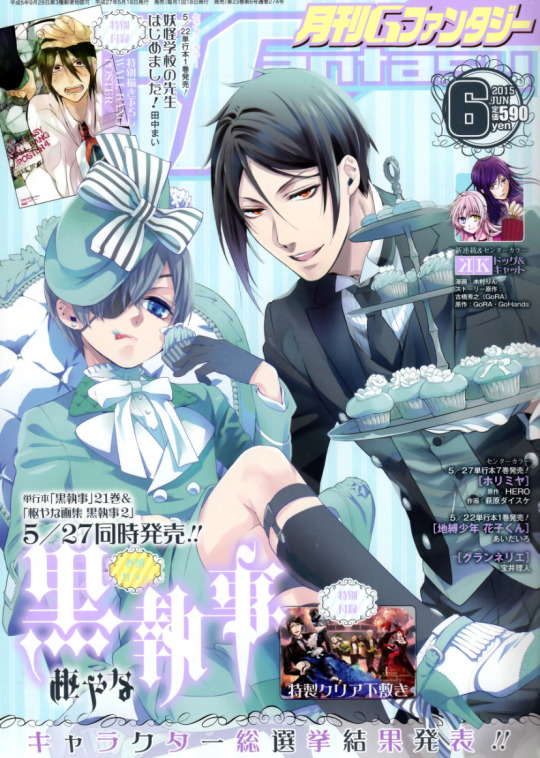
The medium era
I would call 2020 the year of the medium, in the sense that in the magazine (hence in the illustration) we find the characteristics of the previous magazines but with a hint of novelty that will carry over to the present day.I don't know if it is a coincidence, but in the illustration we can see Ciel particularly pale, as if dying. Perhaps this was the symbol heralding the drastic change in the series.
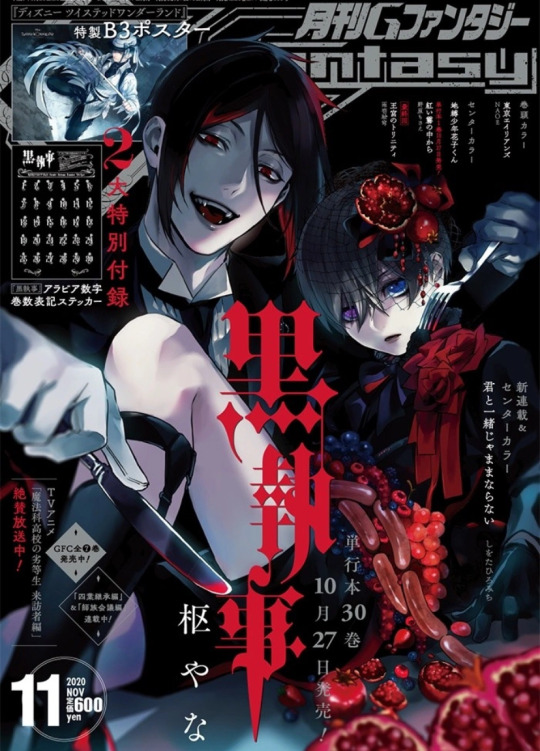
The change era
In 2021, change happens. Not only do we celebrate the 15th anniversary of the series, but the work takes a particularly profound turn, imbued with hidden and often unclear messages.This new vision is not only seen in the illustrations but also in the Black Labels. Before we had simple pop up stores, where the most inventive we had was with the Funtom Hotel (it had nothing to do with the story of the manga) while now with the BR cafe which certainly remains more in the theme, as well as focusing on the Bitter Rabbit (I will bring you an analysis on this later).
The illustrations created by Yanuzza in this period all have a double reading. Magazine of April 2023; where he dedicates a message of love to the magazine, associating their relationship with that of a couple married for thirty years (find the post on page) as if that were not enough, he associated the oyster and the rock with the two protagonists of the series, bringing a very beautiful message indeed.
In the coming days, I will bring you an analysis of the new illustration in G-fantasy magazine and the 15th anniversary illustration. As previously mentioned, these two illustrations will also have a dual reading.
If you are curious to see more of my posts, you can find me on IG as Kuroshitsuji_itaru 😈
#black butler#ciel phantomhive#kuroshitsuji#sebastian michaelis#yana toboso#manga#grell sutcliff#black butler soma#twisted wonderland#anime#illustration
10 notes
·
View notes
Text
Zenless Zone Zero Version 1.4 "A Storm of Falling Stars" Special Issue | Hoshimi Miyabi: Behind the Scenes with the Dev Team (1/2)
Join the dev team for an inside look at the creation of Hoshimi Miyabi~ Ehn-nah!
>> Official Hoyolab post <<
Miyabi's Training
Many New Eridu citizens have seen Chief Miyabi doing her training in some rather unusual places~
During the recent test event at HIA Club, Type II interviewed Deputy Chief Yanagi and got an inside scoop on the training Chief Miyabi has done and might try next! Ehn-na-noo!
✔ Memorizing the names of all her classmates in her graduation photo
✔ Determining percentage of melon content by eating melon products
✔ Never attending debriefings
✔ Meditating on the cable lever on Sixth Street without being discovered by the birds (possibly)
IP
In Miyabi's world, slashing down a sword feels just like chalk against the blackboard, and the sweetness of melons are the people's smiles.
For her, every part of her daily life is just another form of training off the battlefield.
▼Hoshimi Miyabi's Letter in Tsukishiro Yanagi Character Demo - "99+ To-Dos"

Miyabi's training dates back to her childhood.
Born into the distinguished Hoshimi family, a family of martial artists and one of the first-generation Void Hunters, Miyabi was well-educated from a young age and regarded as the most promising heir.
Despite this, her mother wished for her to lead an ordinary and happy life.
Every day, she encouraged Miyabi to practice various skills as part of her training, such as finishing all the vegetables on her plate, sleeping for eight hours, or memorizing the names of all the Hoshimi family members.
This habit became a part of her daily routine, which she upheld even as she grew into a sword master.
▼Miyabi's Childhood Concept Art

Chief's Outfit
The legendary Chief of Section 6's outfit definitely deserves a frame-by-frame analysis!
Speaking of which, the Section 6 fan club has shared a bunch of details with me. Let's check them out~ Ehn-na!
● She's got an ornament of crossed hands on her waist! That's gotta be the signature design for HAND's sections! Uuuwwwaaahhh!
Shared by: Section 6 Fan Club Official
● A pleated skirt with a touch of elegance, but the slit design makes it perfect for moving about on missions. That must be Chief Miyabi's take on fashion!
Shared by: HAND Aesthetics Analysis Group
● Miyabi's gonna look stunning in whatever she wears!!!
Shared by: Your Blade_My Faith
Art
Hoshimi Miyabi's preliminary development was also a process of exploring the artistic style of the characters in Zenless Zone Zero.
For her character design, we considered both urban and fantastical styles. After establishing her background and conducting several internal evaluations, we ended up merging the best of both styles by balancing a professional look suited for urban life with the distinct characteristics of her faction.
▼Early-Stage Concept Art for Miyabi (I)

We even had different opinions on the length of her skirt.
The short skirt fit better with the traditional anime aesthetic and would be more cost-effective for animation production, while the long skirt felt more appropriate for Miyabi's role as the section leader and highlighted her dedication and meticulousness. However, with long hair, a cape, and a long skirt, the risk of clipping in animation would increase significantly, and the workload for each frame would multiply.
▼Early-Stage Concept Art for Miyabi (II)

Finally, we settled on the long skirt version, which better aligns with Miyabi's character, and moved onto the stage of adding details.
In the upcoming Character Demo, Teaser, and EP, we'll be showcasing a variety of artistic styles for Miyabi. We hope players will get to explore all the different sides of her, from past to present, that haven't yet been covered in the game.
▼ A Style Frame in Hoshimi Miyabi's Character Promo Video

Ethereal-Slaying Katana - Tailless
According to records, this sword was forged using a technique unique to the Hoshimi family. It's even said to have been wielded by the first-generation Void Hunter from the Hoshimi family... It must hold some mysterious power!
Many survivors rescued by Section 6 from the Hollows have reported seeing something emerge from this sword... En-na? An eye Thiren?
Art
Ethereal-Slaying Katana - Tailless is a cursed blade. When it comes to the concept of a cursed blade, we tried to interpret it from multiple perspectives.
What came first was to capture the essence of the "curse" within it.
We chose to personify its "cursed" nature by creating a "Tiny Tailless," a creature like a blade spirit. This spirit is the physical form of the curse of the sword. It's a manifestation that appears when the blade is sealed in its sheath and inside a Hollow with high Ether concentration.
▼Initial Concept Art for Tiny Tailless

What follows is the interaction and integration between the "curse" and the "blade." Every time Miyabi uses her skills, Tiny Tailless swiftly retreats into the sword, and its true form flickers in eerie light with each strike. At the same time, a glowing blue paper streamer appears near the hilt and sways in the wind. Once the battle is over and the cursed blade is sheathed, Tiny Tailless emerges and returns to Miyabi's side.
▼Tiny Tailless Returns to the Blade in the Cutscene "Flickering Candlelight"

IP
"Ethereal-Slaying Katana - Tailless" is the name of the cursed blade passed down through the Hoshimi family. its history goes back to when the family wasn't even a big, established "family" yet. As for why it's cursed, there are various versions of the story. In the most popular one, Tailless was forged from the coldest, hardest steel, with the corrupted blood and corpse of each Hoshimi family leader after years of fighting in Hollows — starting with the first-generation Void Hunter.
▼Ethereal-Slaying Katana - Tailless Art Variations

Ethereal-Slaying Katana - Tailless will be an important thread in the new Main Story chapter in Version 1.4. Tailless is not just a sword — it also bears Miyabi's father's seal, HAND's fingerprint lock, and the marks of Miyabi's years of training.
It holds a long-buried past, a story full of twists, and a bond with people worth loving. We hope players will like it in the upcoming Version 1.4.
Void Hunter's Skills
Chief Miyabi's swordsmanship is HAND's confidential information, so there's very little we could dig up!
But Type II won't give up! Thanks to a close Proxy friend of mine, I managed to get Chief Miyabi's annual summary. Let's check it out! Ehn-na-nu!
——————————————————————
Hollow Special Operations Annual Summary
Chief Hoshimi Miyabi
This year, you've killed a total of ■■■■■■ Ethereals,
outperforming 99% of your colleagues.
This year, you've used the training room ■■■ times.
June 19 must be a very special day,
as the record shows that you were still practicing swordsmanship at 3:59 AM.
...
——————————————————————
Uh, if I remember correctly, June 19 is Miss Miyabi's birthday, right...?
Animation
Fast-Paced Combat
The overall pace of combat in Zenless Zone Zero is very fast. In most 3D games on the market, one character can usually only unleash one effective skill in one second, but the characters in Zenless Zone Zero can perform three to four skills in one second. The benefit of this design is that it makes player inputs feel more responsive, the action smoother, and it opens up more combat options, making the game more enjoyable and playable.
Since Miyabi is a warrior who has fought in the Hollows for years and undergone rigorous training, her sword skills must be swift, precise, and efficient. This means that her character animation must capture these characteristics flawlessly in every single frame.
When creating Miyabi's movement animations, our animators had to consider both the game's style and her traits. Whether it's a swing, a slash, or any other sword attack, each action is captured in a dozen to twenty frames.
Let's take Miyabi's Ultimate, Lingering Snow, as an example. The skill begins with an initial attack that surrounds the enemy from all directions, after which Miyabi returns to the center and launches a Finishing Move that deals massive damage.
To reflect the gradual accumulation of power leading to the Finishing Move, Miyabi performs a series of actions within 50 frames: slowing down, abruptly stopping, changing direction, drawing her blade, and then sheathing it. These small details are designed to highlight the speed and precision of her sword skills.
▼Miyabi's Ultimate: Lingering Snow

In terms of character action details, we also hope to reflect Miyabi's personality as best we can. On the battlefield, our focal point became the ending movements of her skills.
Out of a total of 130 motion modules for Miyabi, 25 are dedicated to ending moves. The act of sheathing the blade includes slowly drawing it back, quickly returning it to the scabbard, the metallic impact that follows, and the sense of inertia in the body carrying the sheath. These subtle details all come together to reveal the seriousness and caution this young lady has toward the cursed blade.
We anticipated that, given the fast-paced nature of the game's combat, players would most likely miss some of the final frames during actual gameplay. However, we still wanted to share this as an Easter egg for those of you who enjoy the finer details.
▼Highlights of Miyabi's Ending Moves

Currently, each Agent in Zenless Zone Zero has around 100 to 140 motion modules, which is among the highest in the 3D mobile gaming market. We've tailored body types and animations for each Agent to highlight their distinctive personalities, ensuring that they aren't just playable avatars.
Hoshimi School: Frost
"I don't mean to brag, but she's strong — very strong."
"The sword skills perfected to the extreme are like freezing frost, chilling enemies to the bone, so cold, they burn."
"The way her sword energy bursts out like flames through her hair — that's all her skill right there."
"Ahem... Thank you, Mr. Hoshimi, for having this interview with us! So, how do these martial arts techniques get passed on?"
"Well, that's... a family secret!"
#zenless zone zero#zzz miyabi#hoshimi miyabi#concept art#this one is split into two parts because holy shit its long#a lot about the development of miyabi though!
5 notes
·
View notes